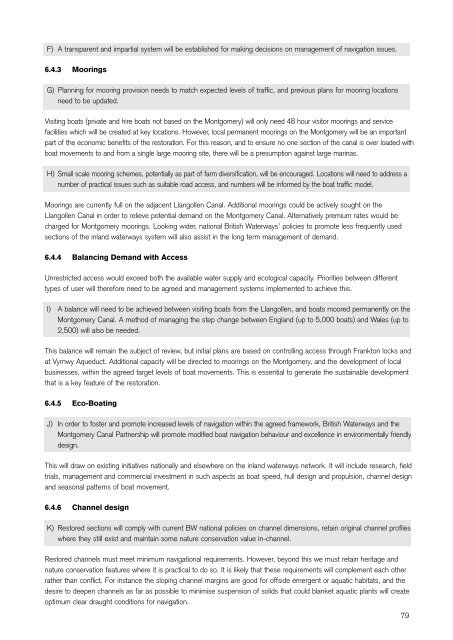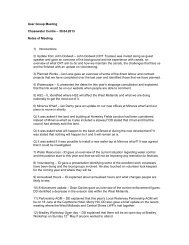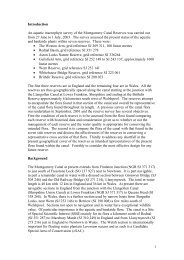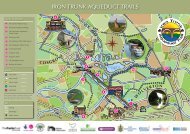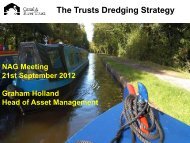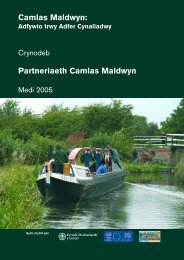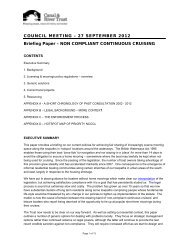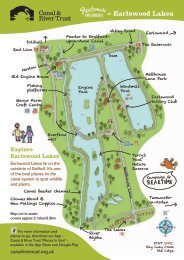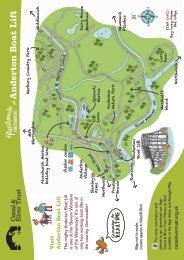Montgomery Canal Conservation Management Strategy (1.2MB PDF)
Montgomery Canal Conservation Management Strategy (1.2MB PDF)
Montgomery Canal Conservation Management Strategy (1.2MB PDF)
Create successful ePaper yourself
Turn your PDF publications into a flip-book with our unique Google optimized e-Paper software.
F) A transparent and impartial system will be established for making decisions on management of navigation issues.<br />
6.4.3 Moorings<br />
G) Planning for mooring provision needs to match expected levels of traffic, and previous plans for mooring locations<br />
need to be updated.<br />
Visiting boats (private and hire boats not based on the <strong>Montgomery</strong>) will only need 48 hour visitor moorings and service<br />
facilities which will be created at key locations. However, local permanent moorings on the <strong>Montgomery</strong> will be an important<br />
part of the economic benefits of the restoration. For this reason, and to ensure no one section of the canal is over loaded with<br />
boat movements to and from a single large mooring site, there will be a presumption against large marinas.<br />
H) Small scale mooring schemes, potentially as part of farm diversification, will be encouraged. Locations will need to address a<br />
number of practical issues such as suitable road access, and numbers will be informed by the boat traffic model.<br />
Moorings are currently full on the adjacent Llangollen <strong>Canal</strong>. Additional moorings could be actively sought on the<br />
Llangollen <strong>Canal</strong> in order to relieve potential demand on the <strong>Montgomery</strong> <strong>Canal</strong>. Alternatively premium rates would be<br />
charged for <strong>Montgomery</strong> moorings. Looking wider, national British Waterways’ policies to promote less frequently used<br />
sections of the inland waterways system will also assist in the long term management of demand.<br />
6.4.4 Balancing Demand with Access<br />
Unrestricted access would exceed both the available water supply and ecological capacity. Priorities between different<br />
types of user will therefore need to be agreed and management systems implemented to achieve this.<br />
I) A balance will need to be achieved between visiting boats from the Llangollen, and boats moored permanently on the<br />
<strong>Montgomery</strong> <strong>Canal</strong>. A method of managing the step change between England (up to 5,000 boats) and Wales (up to<br />
2,500) will also be needed.<br />
This balance will remain the subject of review, but initial plans are based on controlling access through Frankton locks and<br />
at Vyrnwy Aqueduct. Additional capacity will be directed to moorings on the <strong>Montgomery</strong>, and the development of local<br />
businesses, within the agreed target levels of boat movements. This is essential to generate the sustainable development<br />
that is a key feature of the restoration.<br />
6.4.5 Eco-Boating<br />
J) In order to foster and promote increased levels of navigation within the agreed framework, British Waterways and the<br />
<strong>Montgomery</strong> <strong>Canal</strong> Partnership will promote modified boat navigation behaviour and excellence in environmentally friendly<br />
design.<br />
This will draw on existing initiatives nationally and elsewhere on the inland waterways network. It will include research, field<br />
trials, management and commercial investment in such aspects as boat speed, hull design and propulsion, channel design<br />
and seasonal patterns of boat movement.<br />
6.4.6 Channel design<br />
K) Restored sections will comply with current BW national policies on channel dimensions, retain original channel profiles<br />
where they still exist and maintain some nature conservation value in-channel.<br />
Restored channels must meet minimum navigational requirements. However, beyond this we must retain heritage and<br />
nature conservation features where it is practical to do so. It is likely that these requirements will complement each other<br />
rather than conflict. For instance the sloping channel margins are good for offside emergent or aquatic habitats, and the<br />
desire to deepen channels as far as possible to minimise suspension of solids that could blanket aquatic plants will create<br />
optimum clear draught conditions for navigation.<br />
79


